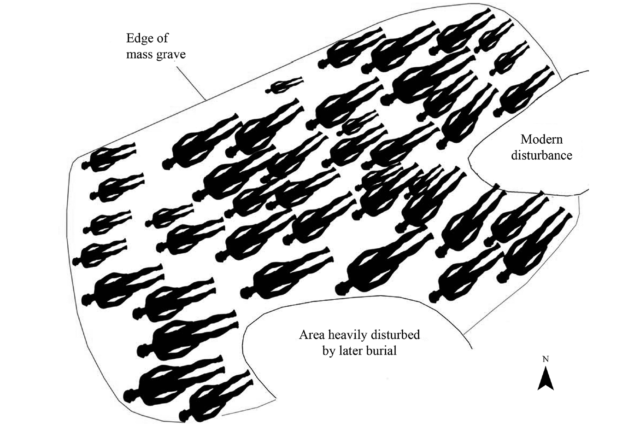Archaeologists recently excavated a mass burial of at least 48 men, women, and children on the grounds of a medieval monastery in Lincolnshire, UK. One persons teeth contained traces of bubonic plague DNA, and radiocarbon dating suggests that these people were victims of a 14th century outbreak. Its the first time archaeologists have found a mass grave for plague victims outside of a city like London or Hereford, and it reveals that even small country villages struggled to bury the masses of plague victims.
A macabre surprise
University of Sheffield archaeologist Hugh Willmott and his colleagues didnt expect to find skeletons when they dug a trench on the grounds of Thornton Abbey. They thought the geophysical anomaly they were preparing to excavate was part of a 1607 mansion built nearby. But instead, they wrote, “the excavation immediately revealed articulated human skeletal remains.” The dead lay in rows, packed so closely that theyd have been touching, with the feet of one row lying between the heads of the next.
Even more surprisingly, the skeletons included at least six women and 21 children, so they definitely werent all monks from the abbey. The 48 bodies in the wide, shallow grave probably included people from the surrounding countryside who died at St. James hospital, adjacent to the monastery. In fact, the grave might have held nearly half the 14th-century population of the surrounding parish, all buried together.
Thornton wasn't alone in seeing its population vanish. Eighteen kilometers (11 miles) away at Meaux Abbey, 40 of the abbey's 50 monks and lay members died in late 1349, and the abbots records report that "the majority of our tenants in different places died." The Thornton find is grim evidence of a medieval farming community overwhelmed by the plague.
Historians typically assume that while the plague devastated rural villages, the smaller numbers made it easier to deal with the bodies of the dead than the losses in densely packed cities like London. But the mass grave reveals that people around Thornton Abbey struggled to keep up with the tide of death around them. “The hospital run by the canons of Thornton Abbey was the last and only functioning institution where local inhabitants could bring the dead and dying to receive a proper burial and hope for salvation in the afterlife,” wrote Willmott and his colleagues.
Bringing out the dead
The mass grave reveals desperation in the midst of disaster. It's “a catastrophic failure of the established system of dealing with the dead,” wrote Willmott and his colleagues, “presumably due to the overwhelming numbers needing to be interred and the scarcity of the living to perform these tasks.” But the grave also proves that the monks of Thornton treated the dead with care, even as they buried nearly 50 people in a matter of days or weeks.

When we think of mass graves, we think of bodies hastily piled on top of each other, but at Thornton, someone took the effort to lay the dead in neat rows all facing the same direction. This care seemed to have been deeply ingrained in the culture; even at the London plague cemetery at Smithfield East, people were placed side-by-side in long trenches, not heaped like dirty laundry.
The shoulders of all but the youngest skeletons seemed to have been squeezed inward, as if a burial shroud had been wrapped tightly around their bodies. No cloth survived after centuries in the ground, but Willmott and his colleagues say that “throughout the grave, the dead were prepared and deposited with great care.”
The progress of the Black Death
Radiocarbon dates from two skeletons suggest that they died sometime between 1295 and 1404. Two silver pennies narrow the date even further; both coins were minted during the reign of King Edward III, between 1327 and 1377. The most obvious conclusion is that the people at Thornton died during the first devastating wave of plague, which swept through England in 1348 and 1349, wiping out between a third and half of the English population in a single fell event.
The radiocarbon dates and the evidence from the coins dont rule out later outbreaks, though, like the one that struck in 1361 and 1362. Historical records claim that children and adolescent boys seemed to die in unusually large numbers during that outbreak, and just over half of those buried at Thornton were 17 or younger when they died.
In the tooth pulp of one molar, Willmott and his colleagues found DNA sequences that matched those of Yersina pestis, the bacterium that causes bubonic plague (your faithful correspondent wishes to note that some scientists still dont agree on whether bubonic plague was the only disease involved in the historical event we now call the Black Death). Plague victims would have carried huge populations of Y. pestis in their bloodstream when they died. That bacteria-laden blood would have carried some of those bacteria to the soft tissue inside the teeth, where bits of their DNA survived centuries of decay and burial.
Willmott and his colleagues speculate that the people who died at Thornton Abbey may have had the same strain of Y. pestis as those who died in London, 290 kilometers (180 miles) south of Lincolnshire. Archaeologists recovered Y. pestis DNA from four people in the East Smithfield cemetery in London. But so far, the sequences from Thornton Abbey arent enough to compare the strains.

arstechnica
[contfnewc] [contfnewc]






